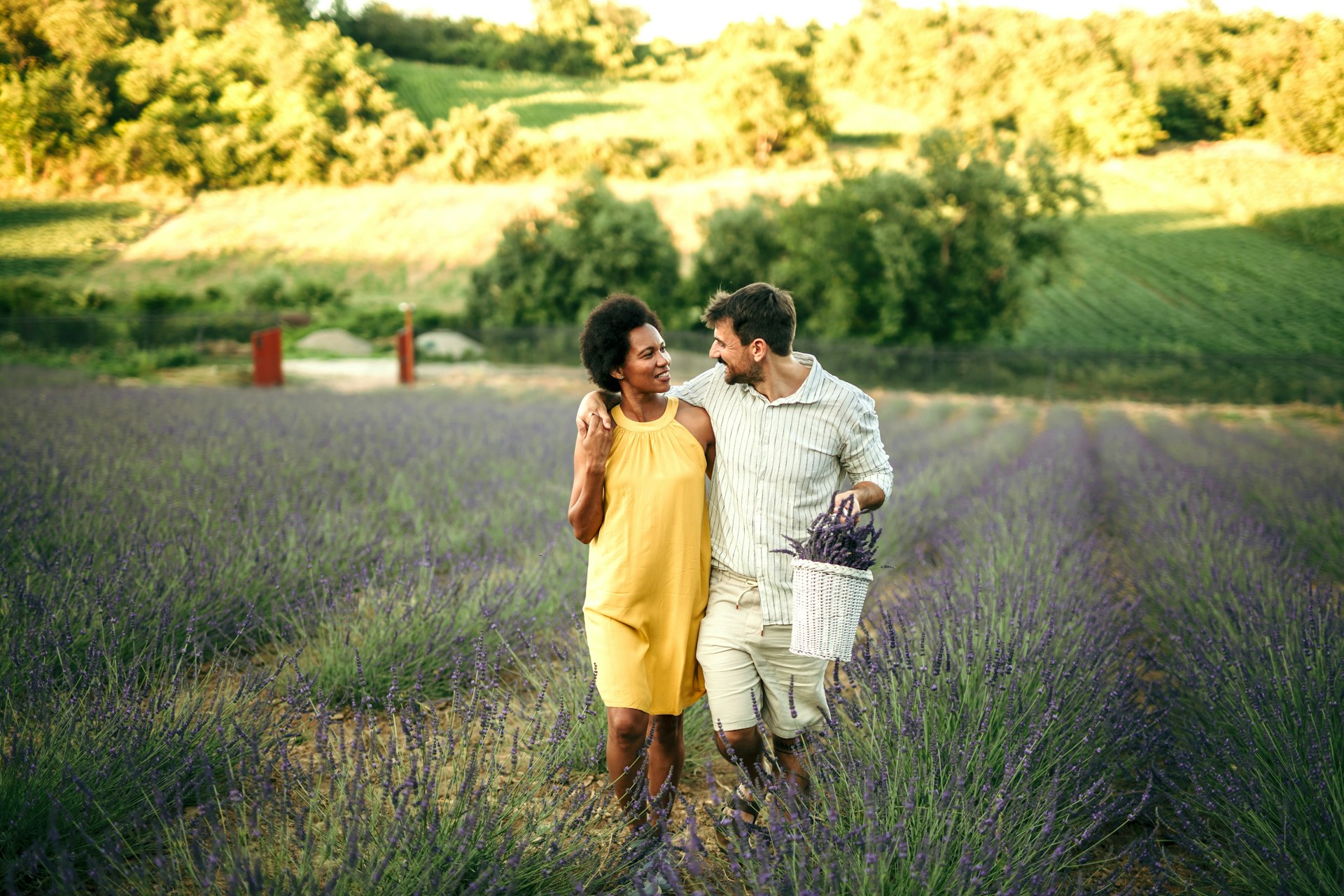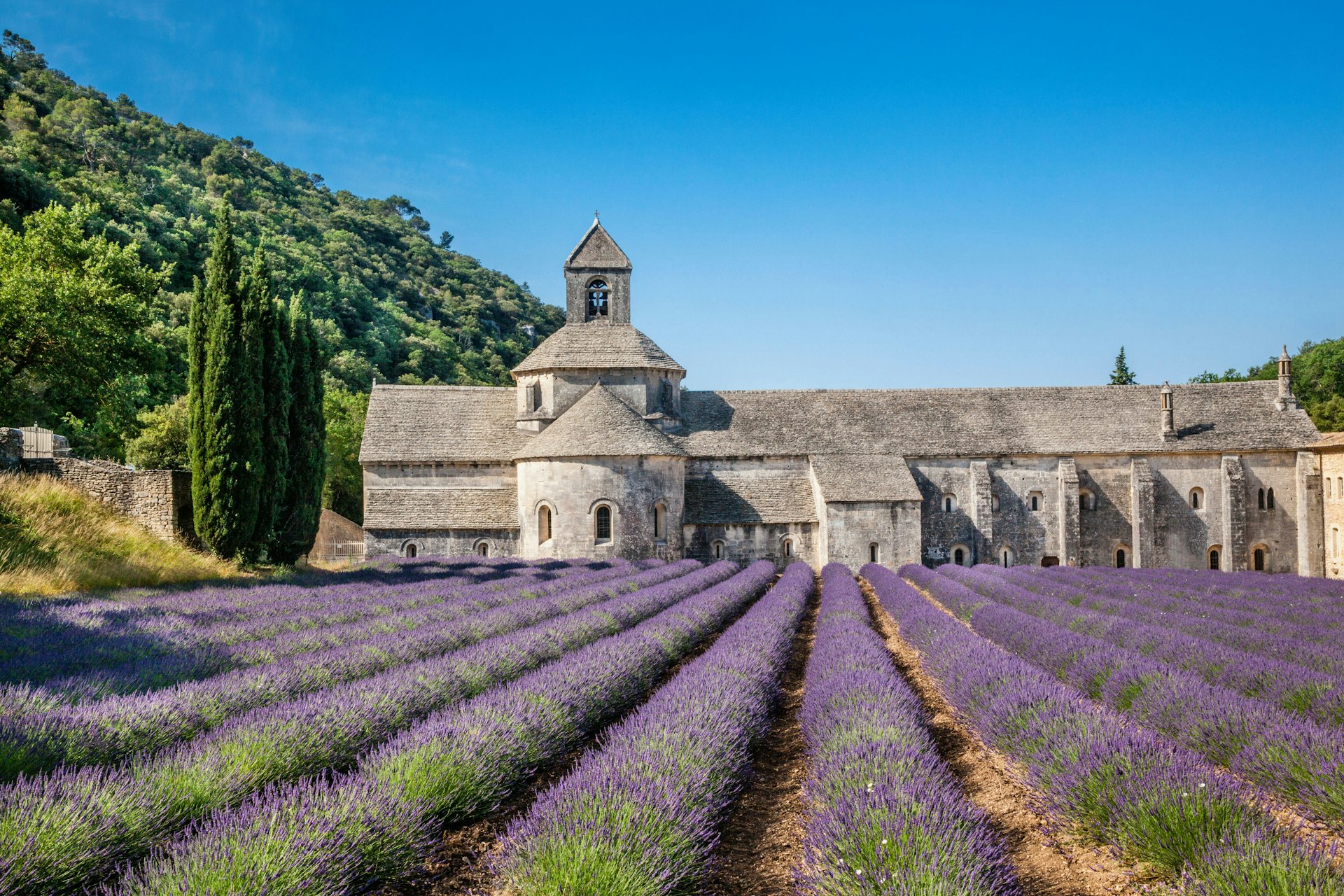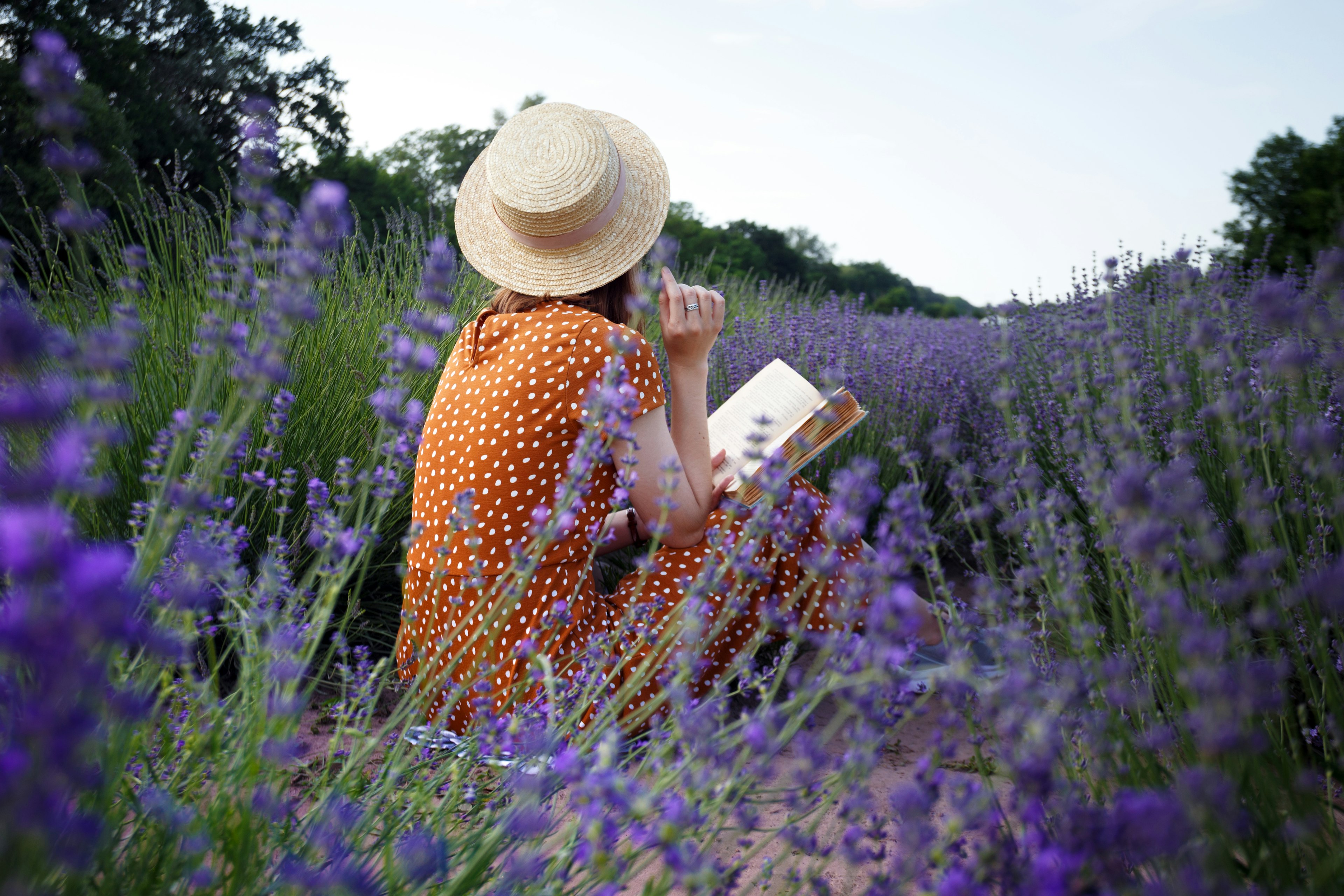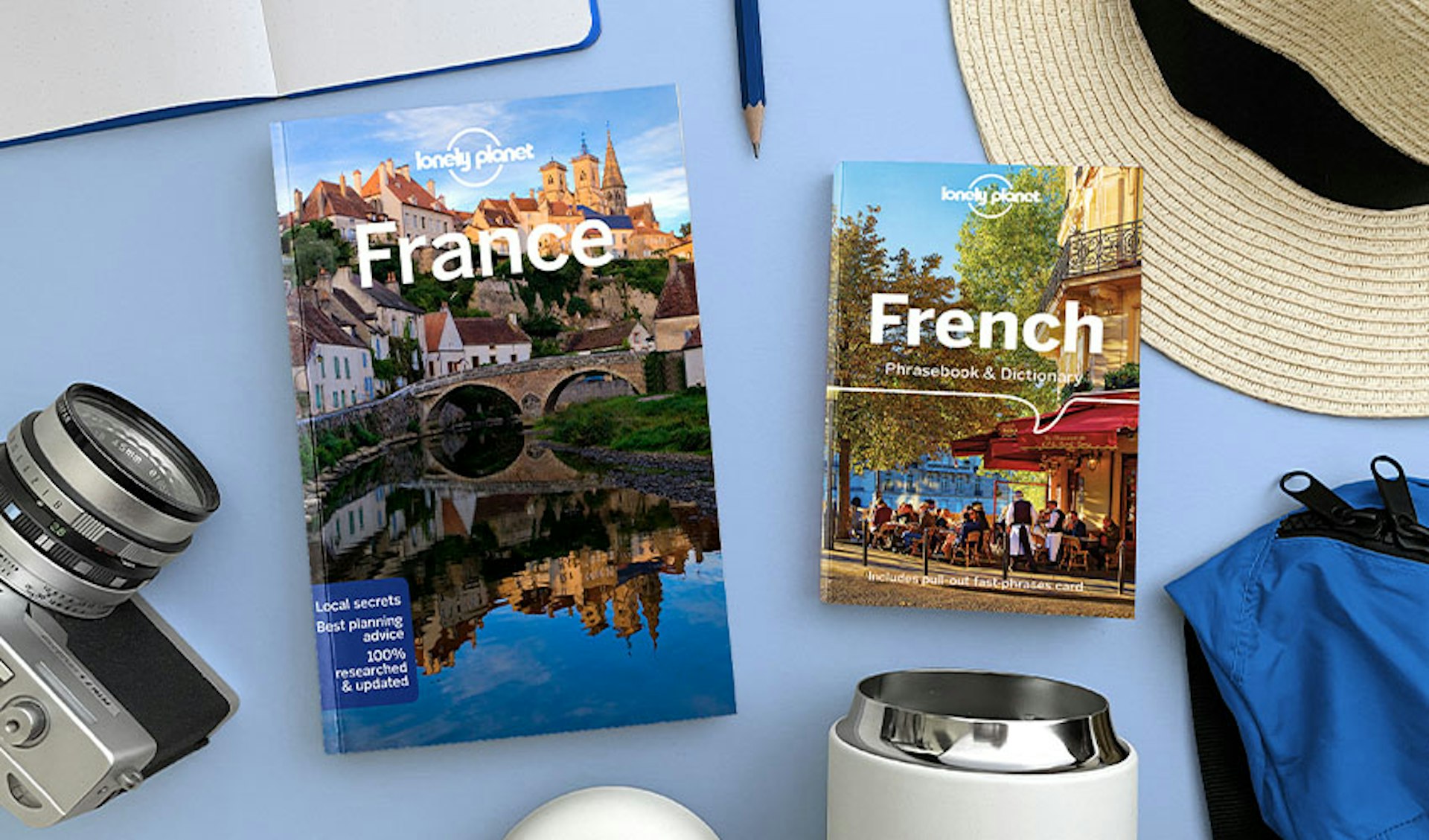If there’s one flower that defines France, it’s lavender, thanks to the vast carpets of purple flowers that cover the countryside of Provence. The beauty of the lavender fields lives up to the hype – get out among the purple haze, sniff the heady summer breezes and navigate picturesque hilltop towns, ancient churches and pretty valleys.
Between mid-June and mid-August – especially around the Luberon valley, the Plateau de Valensole near Manosque and the Sault area – you will be spoilt for choice when it comes to lavender experiences. Lavender has been grown in this region for hundreds of years, and bundles of cut lavender, known locally as paille (straw) are still packed tightly into steam stills to extract their essential oils.
Since 1997, the huile essentielle de lavande de Haute-Provence (Haute-Provence lavender oil) has been protected by its own appellation d’origine contrôlée (AOC), but the vast majority of farms produce a higher-yielding hybrid called lavandin.
This cross-breed of English and Portuguese lavender produces five times more oil than fine lavender, or lavande. Only a handful of farms still cultivate the more finicky lavande species, though these command much higher prices and (according to aficionados) have a much finer aroma.
Many farms and distilleries are open for visits, detailed on the Routes de la Lavande website; an accompanying leaflet is available from local tourist offices. There are also lavender-themed festivals in Valensole (mid-July), Sault (mid-August) and Valréas (early August).
Here’s a guide to cruising France's lavender fields, with detours to mountainside distilleries and trips to scoop up all things lavender at abundant local markets.
Take snaps of purple Provence at the Abbaye Notre-Dame de Sénanque
Isolated and ridiculously photogenic, the 12th-century Cistercian Abbaye Notre-Dame de Sénanque near Gordes is famously framed by lavender. The abbey was founded in 1148 and is still home to a small number of monks. The cloisters have a haunting, severe beauty but reservations are essential if you plan to visit, whether on a guided tour or independently (in the latter case, visitors can borrow an information-packed tablet that shows what abbey life was like in the 13th century). Conservative dress and silence are required; be sure to build in extra time to enjoy the meditative beauty of the lavender fields.
Soar along the Plateau de Valensole
Dreamily quiet Plateau de Valensole, just east of Manosque, has Provence’s greatest concentration of lavender farms. Once you reach Valensole village, make your way to MEA Provence, where you'll find lavender fields, an aromatic garden and exhibition panels about the history of lavender growing on the Valensole plateau. At the shop, you can browse essential oils, soaps, skincare products, dried bouquets, honey, candy, ice cream and other lavender-laced products.

Mingle between lavender and mountains in Sault
This drowsily charming, isolated hilltop town mixes its lavender views with plum orchards and scattered forests. Head to Les Lavandes de Champelle, a roadside farm stand northwest of town, which has great buys for cooks such as fleur de sel (sea salt) infused with Provençal herbs. The lavender up here is known for its dark, OK…deep purple, hue.
The town’s other hot spot is André Boyer, which has kept farmers, cyclists and mountaineers stocked with honey and almond nougat since 1887. Lavender marshmallows and local specialty pognes (an orange-scented brioche) are must-tries. About 30km (19 miles) to the southwest, look out for magnificent views of the red-tinged escarpment and rust-colored village of Roussillon.
The views of 1910m (6266ft) Mont Ventoux, 25km (15.5 miles) to the northwest, are similarly awe-inspiring. Nicknamed le géant de Provence ('the giant of Provence'), this great white hulk is visible from much of the region. The peak sparkles all year round – once the snow melts, its bare limestone slopes glimmer in the sun; from the summit, clear-day vistas extend to the Alps and the Camargue.
Climb through village lanes for views of St-Saturnin-lès-Apt
St-Saturnin-lès-Apt is a refreshingly ungentrified village, 10km (6km) north of the large town of Apt, with marvelous views of the surrounding Vaucluse plateau punctuated by purple lavender fields. Climb to the ruins atop the village for a knockout vista. At Moulin à Huile Jullien, you can see how olives are milled into oil, with honey and oil tastings thrown in.
Smell all the flowers at Prieuré de Salagon
This beautiful 13th-century priory on the outskirts of Mane is today home to lovely gardens and a diverting museum. This is ethnobotany at its most poetic and sensual – you can wander through recreated medieval herb gardens, fragrant with native lavender, mints and mugworts. Inside the medieval walls, the museum's exhibitions provide a fascinating insight into rural life in Haute-Provence.
The walled town of Mane is lovely for strolling, too, and the Pont Roman de Mane is also worth a look. This triple-arched stone bridge crossing the trickling River Laye dates from the 12th or 13th century and it makes a fine spot for a picnic.

Sweep through the fields of the Southern Luberon
The southern half of the Luberon is equally florally blessed. Lavender carpets the Plateau de Claparèdes between Buoux (west), Sivergues (south), Auribeau (east) and Saignon (north). Cycle, walk or motor through the lavender fields and along the northern slopes of 1125m (3691ft) Mourre Nègre, the Luberon’s highest point, accessible from Auribeau.
Traveling by car or bike, the D113 climbs to the idyllic lavender distillery of Les Agnels, which produces lavender, cypress and rosemary essential oils. The small on-site spa has a lavender-scented swimming pool. Stay at L'Auberge du Presbytère in tiny Saignon, which perches on a high rocky slope, its narrow streets ringed by craggy scrub and petite lavender plots, with incredible vistas across the Luberon to Mont Ventoux.
Cycle through the lavender fields for maximum fragrance
There's no better way to breathe in the rich lavender aromas than exploring by bike. La Provence à Vélo can point you towards classic cycle routes, including one through some of the loveliest lavender fields in the region, following a 33km circular route around the Plateau de Sault.
When are the lavender fields in bloom?
If you love lavender in bloom, mid-June to mid-August is the time to catch it flowering in Provence (July is prime time, but June is impressive too). However, you won't be the only visitor. The schools are out for summer, filling the countryside with tourists, traffic and too many complet (full) signs strung in hotel windows – book well ahead.
The sweet-scented flowers are mechanically harvested when in full bloom, between 15 July and 15 August on a hot dry day. Lorry loads of cut lavender are then packed into steam stills and distilled to extract the sweet essential oils. You can watch the process at the Distillerie du Siron, a traditional, family-run distillery and organic flower farm covering 20 blazing hectares near the medieval village of Thoard, northwest of Digne-les-Bains.

Best lavender experiences (when the fields aren't in bloom)
If you miss the blazing blossoms in summer, it's still worth visiting to see the spring-green lavender fields of Haute-Provence and the Luberon or the autumn-winter fields, a cropped wash of pale grey-blue. And at any time, you can hit other experiences based around this delectable flower.
Just outside the village of Coustellet, the Musée de la Lavande is an excellent eco-museum and working lavender farm where you can immerse yourself in the traditions and history of this Provençal icon and buy lavender goodies in the on-site boutique. Afterward, the hilltop village of Gordes is worth a detour, especially at sunset, followed perhaps by a drink on the panoramic terrace at the lavish Bastide de Gordes hotel.
Or hit the area’s other Musée de la Lavande in Digne-les-Bains, which explores Provence’s lavender-growing culture and stages distilling sessions in its courtyard during summer. The largest town for some miles around, Digne-les-Bains is the capital of the département of Alpes-de-Haute-Provence and an important lavender processing center, but it's a little short on must-see sights otherwise.
About 50km (31 miles) southwest, Forcalquier has an upbeat, slightly bohemian vibe, a holdover from the 1960s and 1970s, when artists and back-to-the-landers arrived in the area, fostering a now-booming biologique (organic) movement. Saffron is grown here, absinthe is distilled, and the town is home to the unusual Université Européenne des Senteurs & Saveurs (UESS; European University of Scents and Flavors).
To see it all in action, time your visit to coincide with the Monday morning market. You can also pop in for a drink, a Michelin-starred meal and (if your budget allows) an overnight stay at the luxurious Couvent des Minimes, owned by fragrance house L'Occitane.
The best lavender treats to buy, smell, and taste
Some 80% of the essential oils produced in the region’s 150 distilleries is exported, but the other 20% makes its way to local markets and into the local cuisine and toiletries. Distinctive to Provençal cuisine is the use of lavender as a flavoring – the flowers scent herbal teas, tart up desserts and spice grilled meats, and lavender leaves float in fragrant soups. You’ll also find lavender in ice cream, chocolate, and of course the region's amazing honey. And don’t pass up a lavender crème brûlée if you see it on the menu.
Throughout the region, weekly food markets are filled with trestle tables groaning under the weight of marinated olives, goat's cheese, honey, peaches, melons and a bounty of other sun-kissed fruit, veggies and seasonal food. And, of course, lavender is well represented – from lavender sachets for scenting bedclothes to lavender honey. Keep in mind that some lavender delectables are available at local supermarkets, too.
When shopping for lavender, it's worth knowing that the most sought-after product is fine lavender (Lavandula angustifolia, Lavandula vera, or Lavandula officinalis), not spike lavender (Lavandula latifolia) or the hybrid lavandin (Lavandula hybrida). The latter plants are high in camphor and are used mainly to produce detergents, cosmetics and natural paint solvents, not perfume.
The town of Manosque has two lovely fountains and a historic cobblestoned core, but the traffic and suburban nothingness make visiting a nuisance. So why swing by? Just southeast is the factory home of L’Occitane, the company that turned traditional lavender-, almond- and olive oil–based Provençal skincare into a global phenomenon. Factory tours can be booked online; the shop offers a flat 10% discount and there's also a small Mediterranean garden to peruse.



